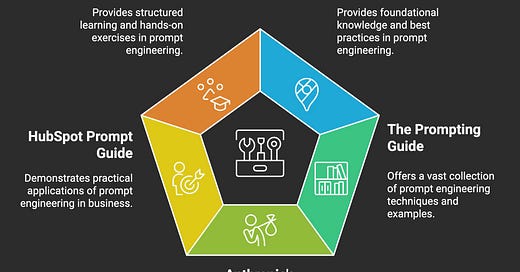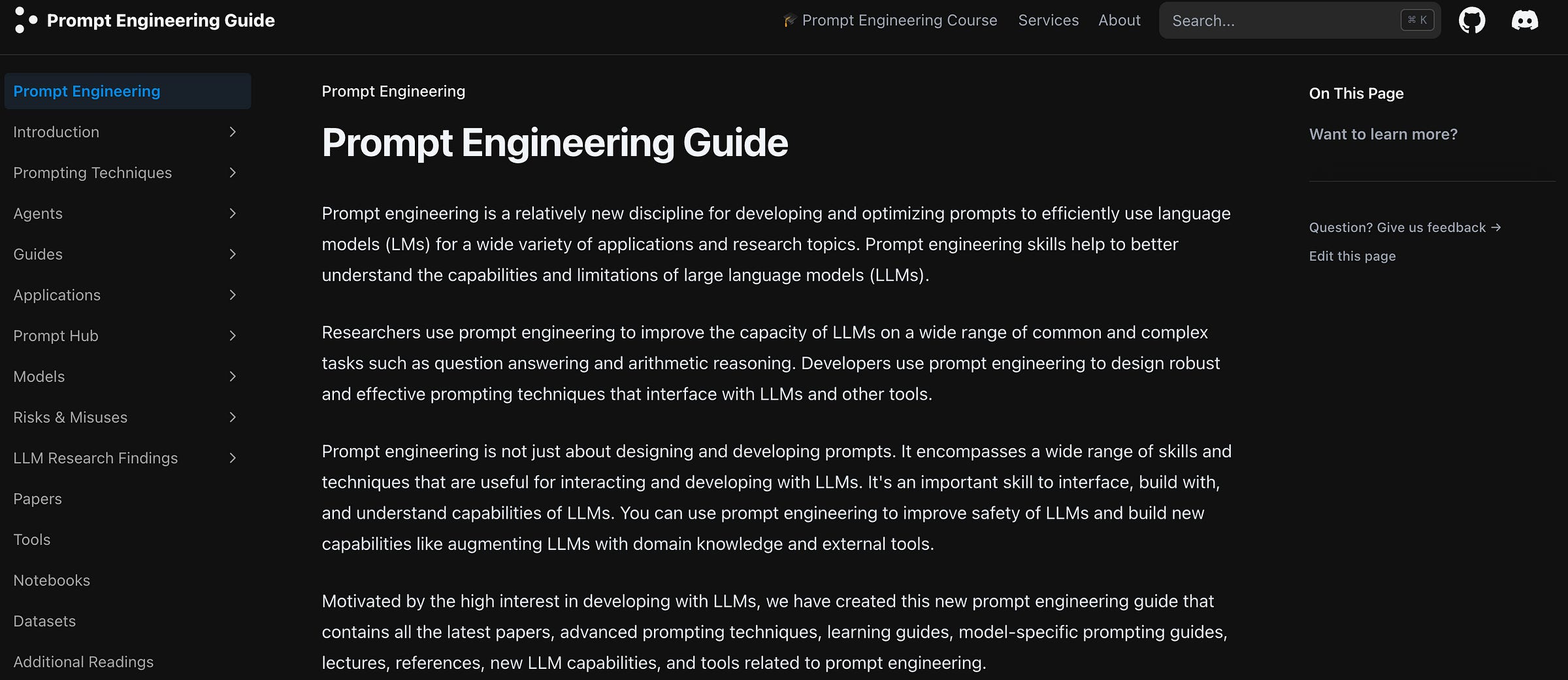Prompt Engineering Guide- Learn to prompt effectively and steal my course notes from DeepLearning Prompting course
Prompt Engineering Resources from resources from Google and HubSpot
Unlocking AI's Potential: A Tutorial on Prompt Engineering
The Art and Science of Talking to Machines
In the rapidly evolving landscape of artificial intelligence, the ability to effectively communicate with AI models has become a crucial skill. This is where prompt engineering comes in—a discipline that focuses on crafting optimal prompts to elicit desired responses from AI.
What is Prompt Engineering?
At its core, prompt engineering is the process of designing and refining text inputs, or "prompts," to guide AI models like GPT-4. Think of it as the art and science of having a conversation with a highly intelligent, yet sometimes unpredictable, digital entity. By understanding how these models interpret language, we can craft prompts that unlock their full potential.
From my experience, it's like learning a new language, but instead of talking to people, you're talking to an AI. I've found that the more precise I am, the better the results I get.
Why is Prompt Engineering Important?
Prompt engineering is a critical skill in the AI era. It directly impacts how effectively AI models understand and generate responses. Here are three compelling reasons why mastering prompt engineering is essential:
1. Precision and Accuracy in AI Responses
AI models generate responses based on the input they receive. A poorly designed prompt can lead to vague or misleading answers, while a well-structured prompt ensures clarity and accuracy.
Example:
❌ "Tell me about AI." → Too broad, resulting in a generic response.
✅ "Explain how transformer-based models like GPT-4 improve natural language processing with an example." → Results in a detailed, relevant answer.
2. Efficiency and Productivity Boost
A well-crafted prompt saves time by getting the desired response in one go, rather than needing multiple iterations. This is particularly valuable for businesses, researchers, and content creators.
Example:
❌ "Generate a marketing email." → The AI might produce a generic template.
✅ "Generate a persuasive marketing email for a fitness app targeting busy professionals, highlighting convenience and personalized training." → The AI delivers a refined, usable output immediately.
3. Unlocking Creativity and Advanced AI Capabilities
Prompt engineering allows users to explore AI’s creative potential by structuring prompts in ways that encourage unique and insightful outputs.
Example:
❌ "Write a story." → AI might generate something generic.
✅ "Write a futuristic sci-fi story about a world where AI governs human decision-making, but one human finds a flaw in the system." → AI generates a more imaginative and contextually rich story.
Key Concepts and Techniques
Prompt engineering involves a variety of techniques, ranging from simple to complex. Here are some fundamental concepts:
Clear and Specific Instructions: The more precise you are in your prompt, the better the results will be. Avoid ambiguity and clearly state your desired output.
Example:
Poor Prompt: "Write something about climate change."
Good Prompt: "Write a 200-word summary of the key findings from the latest IPCC report on climate change, focusing on the impact on coastal communities."
When I started, I'd give really vague prompts, and the results were all over the place. But as I learned to be more specific, the AI started giving me exactly what I needed.
Context is King: Providing relevant background information helps the AI model understand the intent of your prompt.
Example: "You are a travel agent specializing in eco-tourism. A client is interested in visiting Costa Rica. Suggest three destinations and briefly describe the unique wildlife and conservation efforts in each location."
I remember using this technique when I was trying to get an AI to write a blog post for my website. By giving it a persona and context, the AI was able to write in a much more engaging and relevant style.
Role Assignment: Assigning a specific persona or role to the AI can influence the style and tone of its response.
Example: "You are a renowned historian specializing in ancient Rome. Explain the significance of the Roman Forum in no more than 150 words."
This is a game-changer! I've used this to have AI write in the style of different authors, and it's surprisingly effective.
Few-Shot Learning: Providing a few examples of the desired input-output format can guide the AI model and improve its performance on similar tasks.
Example:
"Translate the following sentences into French:
'Hello, how are you?' -> 'Bonjour, comment allez-vous ?'
'Thank you very much.' -> 'Merci beaucoup.'
'What time is it?' -> "Quelle heure est-il ?'
'Good morning' -> "..."
This technique is incredibly useful for tasks like translation or code generation. It's like showing the AI a couple of examples and then letting it take over.
Chain of Thought (CoT) Prompting: For complex reasoning tasks, CoT prompting encourages the model to explain its reasoning process step by step, leading to more accurate and reliable results.
Example: "The cafeteria had 23 apples. If they used 20 to make lunch and bought 6 more, how many apples do they have? Let's think step by step."
I've used this a lot for math problems and logic puzzles. It's really cool to see how the AI breaks down the problem step by step.
Iterative Refinement: Prompt engineering is an iterative process. Don't be afraid to experiment with different phrasings and approaches to see what works best.
This is something I've learned the hard way. You rarely get the perfect prompt on the first try. It's all about experimenting and tweaking until you get the desired result.
Tools and Resources
Several tools and resources can aid in your prompt engineering journey:
Google's Prompt Engineering Guide: A comprehensive resource that provides in-depth information on prompt engineering techniques and best practices.
The Google guide is a must-read. It gave me a solid foundation in prompt engineering and helped me understand the underlying principles.
The Prompting Guide: A massive collection of prompt engineering techniques, from basic to advanced.
The Prompting Guide is my go-to resource for trying out new techniques. It's got a huge collection of examples and best practices
Anthropic's Prompt Engineering Documentation: Tips and tricks on how to refine your prompts.
I found Anthropic's documentation to be very practical, especially their section on prompt refinement. Their "prompt improver" techniques are really useful.
HubSpot AI Prompt Guide: Practical applications of prompt engineering
The HubSpot guide is great for seeing how prompt engineering can be applied in real-world business scenarios, particularly in marketing
DeepLearning.AI Courses: Offers courses on prompt engineering, providing structured learning experiences and hands-on exercises.
The DeepLearning.AI course was incredibly helpful. The hands-on exercises really solidified my understanding of the concepts.
Here are my Notes
* Temperature of the model
* For predictable response Temp = 0 ,higher for creative
* Guidelines
* Based LLM vs Instruction Tuned LLM
* Based LLM
* Predicts next word, based on the TEXT TRAINING Data
* Instruction Tuned LLM
* Tries to follow Instructions
* Fine Tune instructions and good attempts at following those instructions
* RHLF- Reinforcement Learning with Human Feedback
* Prompting Principles
* Principle 1: Write Clear and specific instructions
* Tactic 1 - Use delimiters (Helps avoid Prompt Injections)
* Triple quotes: """
* Triple backticks:'''
* Triple Dashes ---
* Angle Brackets <>
* XML Tags: <tag> </tag>
* Tactic 2- Ask for Structured Output HTML/JSON
* Tactic 3 -
* Check weather conditions are satisfied
* Check assumptions required to do the task
* Tactic 4- Few Shot Prompting
* Give successful example of completing tasks
* Then ask models to perform the tasks
* Principle 2: Give the model time to “think”
* Tactic 1
* Specify the steps to complete the task
* Instruct the model to work out its own solution before rushing to conclusion
* Model Hallucination
* Makes statements that sounds plausible but are not true
* Reducing Hallucinations:
* First find relevant information then answer the question based on the relevant information
* Iterative-prompt-development
* Give the prompt to generate an output based on the instructions
* Issue 1 - Text is too long
* Limit the number of words/sentences/characters
* Issue 2. Text focuses on the wrong details
* Ask it to focus on the aspects that are relevant to the intended audience
* Issue 3. Description needs a table of dimensions
* Ask it to focus on the aspects that are relevant to the intended audience.
Conclusion
As AI continues to evolve, prompt engineering will become even more critical. The ability to effectively communicate with AI will be a valuable skill in various fields, from software development and data science to marketing and education. By mastering prompt engineering, we can unlock the full potential of AI and shape a future where humans and machines work together seamlessly.






